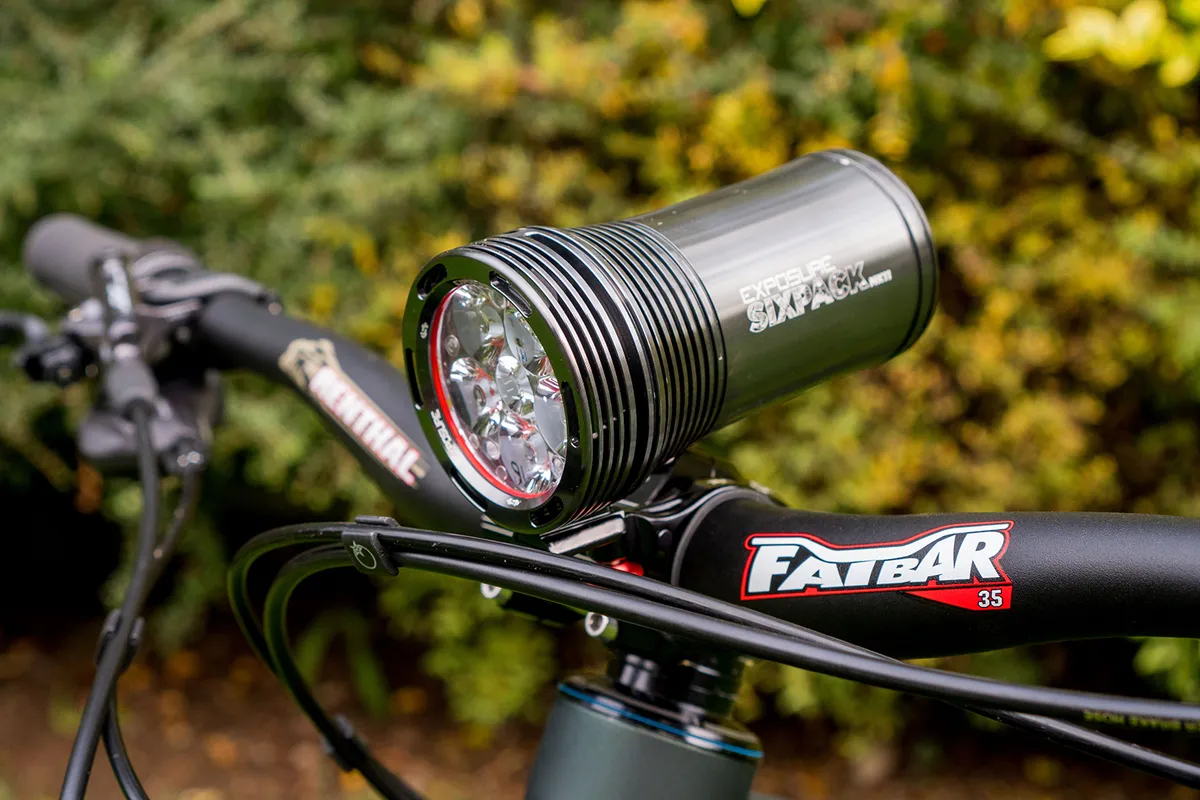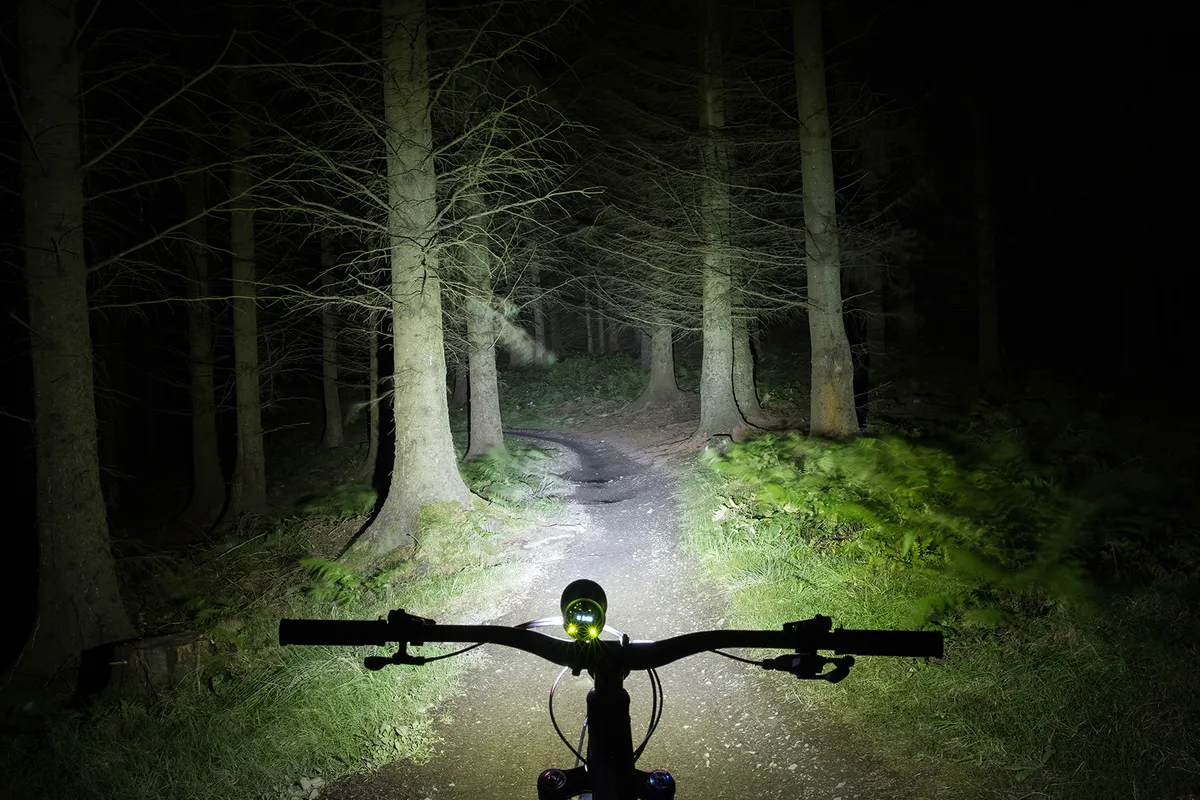Exposure’s Six Pack MK11 light is the brand’s highest output light, boasting up to 5,000 lumens in its motion-sensitive Reflex setting.
That illumination is generated by six forward-facing XPL2 LEDs, which can be switched between 10 operating modes.
Packing this much punch comes at a price – both monetary and in weight – with the all-in-one unit plus bar clamp weighing a whopping 424g.
The light’s not small either, measuring 114mm long and 49mm wide and deep, and using a 15,500mAh battery.
The single rear-facing button operates the light, where a double push turns it on, then a long push and subsequent single pushes cycle between the 10 modes.
In four of the 10 modes, there are three power settings, while the others have two.

The rear-facing OLED display provides mode information, remaining battery charge and run time. Coloured LEDs – which change from green, amber to red – correspond to the light’s mode and indicate battery life.
The Six Pack features Exposure’s Reflex technology, where in-built 3D accelerometers determine your speed and analyse how rough or demanding the trail conditions are and increase/decrease the light’s output accordingly.
The idea of this system is to prolong battery life, so the light only provides maximum power when it is required.
The tech takes about 20 minutes of riding to calibrate initially, and in this mode, the Six Pack MK11’s output can be increased to 5,000 lumens.
The bar clamp is compatible with both 31.8mm and 35mm diameter bars, and tightens with a 4mm Allen key. The quick-release light fitting system uses a wedge with a sprung pin to hold the light in place.
Exposure Six Pack MK11 performance
Power output is impressive in both the Reflex and maximum constant modes, feeling very close to Exposure’s claims.
The beam is well spread out, with ample light to choose your lines and view features outside of the focal point. That central focal point feels quite soft in comparison to the harshness of some lights, such as the NiteRider Pro 4200 Enduro.
This means there’s no excessive contrast or excessive shadowing, and the power is delivered evenly and really saturates the ground, highlighting every detail.
There’s also a reasonable spread of light from side to side, with a gradual but short cut-off at the periphery. The quick fade to dark means it’s possible to see the beam’s cut-off while riding, and this comes into play when picking lines on the exits of turns.
When the pace really picks up or there are successive tight turns, it can be tricky finding your line on the exit of a corner when you’re at the apex.
With the sheer amount of power on tap, the Six Pack MK11 feels a little stunted, where wider-angled lenses could vastly improve its peripheral illumination.

On tight, twisty trails, it would greatly benefit from a dedicated helmet-mounted light and, when paired with one, it’s almost unbeatable.
On straighter, faster trails this was much less of an issue, and the Exposure was virtually faultless, thanks to a long light throw that had an imperceptible cut-off ahead of the beam.
The beam has two defined colours: closer to the bike it’s yellow and green, further away it changes to a whiter hue.
This is a great mix that blends high definition down the trail with a softer, less dazzling light closer to the rider. It’s spot-on for seeing obstacles.
Although it’s not hugely intuitive to operate, with a range of button pushes to access different features, once the functionality is committed to memory it becomes easier. Reading the instruction manual is vital to understanding operation.
The Reflex mode is outstanding, however, and it invariably selected the correct illumination for the trails I was riding. It ‘wakes up’ instantly, so you don’t need to pre-agitate the light before setting off down a trail.
It’s a true masterpiece of technology, and selecting Reflex turns the Six Pack MK11 into a true fit-and-forget light, where you only need to turn it on at the start and off at the end of a ride.
Its display and corresponding LED indicators are clear to view and denote easy-to-consume information with a cursory glance. They aren’t bright enough to distract, either.
During testing, the light lasted 1hr 59mins on its constant max power mode. This is virtually identical to Exposure’s claims.
The clamp is elegant and slim, attaches easily to the bar – thanks to an upward-facing 4mm Allen bolt – and proved to be robust and stable despite the Six Pack’s heft.
The quick-release light mount is also easy to use, so light removal takes just a second.
Because it positions the light above the bar, the all-in-one unit does take up a fair amount of bar real estate, but this is only a problem if you want to mount lots of accessories.
Exposure Six Pack MK11 bottom line
The technology inside the Six Pack MK11 is tremendously impressive and, as a package, it’s virtually faultless.
It’s just a shame the immense power isn’t spread a bit more evenly.
How we tested
For our 2021 MTB lights test, we put eight units to the test, starting at just over £100 and rising all the way to nearly £500.
Whatever your budget, there should be one that will suit your needs.
Of course, there are plenty of lights available online for less money, but they won't necessarily offer the same reliability or aftersales support as the trusted brands tested here.
All the lights chosen have a minimum output of a claimed 1,500 lumens, but some are much brighter. Generally, more lumens equates to a higher price.
As well as testing how each light performs on the same trail on back-to-back runs – assessing beam pattern, LED colour, ease of operation and, most importantly, light projection – we also timed them all on max power to find out just how long the batteries last, and whether they live up to the brand’s claims.
You can find all of our top-rated options in BikeRadar's guide to the best mountain bike lights.
Also tested
Product
| Brand | Exposure |
| Price | A$699.00, €522.00, £435.00, $596.00 |
| Weight | 424g |
Features
| Integrated battery | yes |
| Features | Output: 3,600 lumens (constant), 5,000 lumens (Reflex mode) Run time: 1hr 59mins (measured) |
